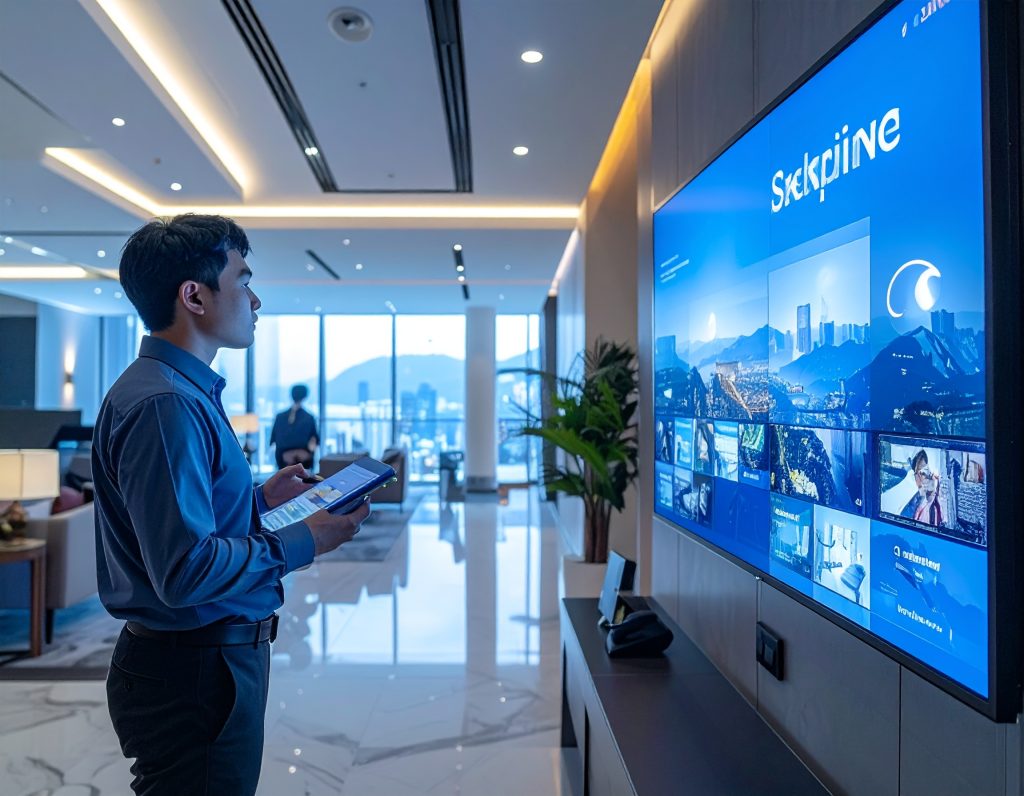Visitor Tracking Software – Benefits, Case Studies, and Q&A
6 Feb 2023
Keeping track of a business is challenging work. You need to stay on top of employees, profits, and management. With that in mind, it’s not surprising that most organizations struggle to maintain a record of visitors.
Why does keeping track of visitors matter?
Visitor tracking means improved security, better resource management, and more control over managing a specific location.
Keeping track of a business is challenging work. You need to stay on top of employees, profits, and management. With that in mind, it’s not surprising that most organizations struggle to maintain a record of visitors.
Why does keeping track of visitors matter?
Visitor tracking means improved security, better resource management, and more control over managing a specific location.
It lowers the possibility of threats to staff and customers and empowers business owners to more effectively maintain a record of everyone on-site at a given time. Plus, it means better customer service through personalization, which is especially important when 54% of customers globally have higher customer expectations each year.
That being said, visitor tracking needs to be done effectively. Spending too much time and human resources on maintaining a record of visitors is less efficient in the long run.
Visitor tracking software is currently the most effective, efficient manner of tracking visitors within a business.
Read on to find out more about visitor tracking options, common issues with visitor management, and the best way to pick a visitor tracking software for your company.
Types of Visitor Tracking
From guest books to visitor tracking software, the evolution of visitor management has grown alongside technology. Here’s an overview of the types of visitor management systems that exist.
- Physical Visitor Records
- Manual Registration
- Registration Kiosks
- Cloud-Based Visitor Tracking Software
Physical Visitor Records

Guest books are most often associated with hotels or restaurants, due to the importance of maintaining a tidy guest list for service purposes.
With a physical record, visitors or a greeter scribble names and dates into the books to maintain an organized check-in system. For individually run businesses such as real estate or small inns, guest books provide a simple centralized location for customers to check-in.
Guest books have a simplistic charm since there’s no need to access more complicated technology than a pen and paper. Plus it’s self-serve, eliminating the need for staff to tend to guest check-in.
Although it’s more convenient than a headcount, keeping track of visitors through guest books is problematic due to:
- Lack of accuracy. How can you account for miswritten details or bad handwriting? Handwritten records are fallible due to how inconsistent they can be.
- No security. Paper guest books are easily lost or damaged. Spill a cup of coffee on your record might be enough to lose you several pages of guests’ information.
- Missing analysis/feedback. Physical documentation of visitors is just that: a visitor management system without the critical insight that helps elevate your business performance.
Despite their charm, guest books have become relics of the past at more advanced organizations seeking more efficient ways to operate.
Manual Registration
Compared to guest book registration, manual registration allows for superior organization and centralization. On-site staff register each visitor when they arrive, whether through paper documentation or logging their information into an online system via a computer.
On-site staff can provide a personal touch to service, answering any queries customers may have. Manual registration is commonly seen in hotel lobbies since there is always front desk staff on shift to assist guests with check-in.
While manual registration can work well for certain types of businesses, it’s not always the most efficient method to check in clients.
- Time-consuming. Your staff needs to manually check each client in at the door. It’s a thorough process but will take time out of their day they could spend on less menial tasks.
- No backup. A centralized online visitor tracking system might be appealing, but it’s difficult to back up when virtual security threats arrive on your doorstep.
- No analysis. Once again, a visitor management system without feedback is only effective at serving as a log of people who have stayed. There’s no performance-enhancing analysis to help you improve work processes.
Manual registration has eliminated some issues with keeping a physical guest book. Even so, there are better ways to keep track of visitors that don’t involve your employees tracking them through individual checking in.
Registration Kiosks

Kiosks represent the first step into a realm where your employees are no longer responsible for making sure visitors check in manually. Simply set up self-service kiosks and your customers will be able to register their visit directly on-site.
Unlike previous methods of registration, kiosks solve the issue of needing employees to guide guests through the whole process. With an intuitive enough interface, most customers will have a breezier experience with kiosks than with person-to-person interactions.
There are still a few downsides with kiosks, however.
- Costly. Specialized ticketing kiosks can be big and clunky. You can make use of a tablet on a stand instead, but this is still expensive compared to paper or digital solutions.
- Space-intensive. You’ll need a spacious location to fit kiosks, customers, and a queuing area. Kiosks are not good for businesses with smaller physical locations.
- Remote-unfriendly. Customers nowadays are accustomed to ordering online. Kiosks are incompatible with customers who wish to order remotely and pick up on-site: you’ll need a separate solution for that.
Kiosks can be part of a great visitor tracking system. If you’re looking for a more inclusive solution, however, they’re not the full answer.
Cloud-Based Visitor Tracking Software
What’s the best part about cloud-based visitor tracking software? How compatible it is with other visitor tracking systems. You can still offer registration through kiosks or on-site. A cloud-based solution ties everything together. They’re versatile and will work for any business, from government registration sites to real estate agents operating from location to location. If you’re looking to reduce traffic, they can even eliminate in-person visits by offering virtual service delivery.
Since visitor tracking software isn’t the most common type of visitor tracking system, let’s start by defining it:
A cloud-based visitor tracking software is a software solution that performs all the visitor tracking functionality without requiring the hassle of:
- Physical location limitations
- Costly machinery
- Time-consuming face-to-face service
- Fallible physical records
These tools are designed for easy self-check-in. They often come with built-in analytics and reporting to ensure you’re tracking the data you need to streamline your visitor experience for the future. Other functions include:
- Access management. Employees can issue or revoke access to different parts of a given building.
- Customer profile. Deliver highly personalized service to customers based on their pre-existing profile and records.
- Real-time status documentation. Working in a service industry such as beauty or wellness where customers move through your site throughout a visit? Your visitor tracking solution can update you on where they are and where to meet them.
That’s a lot of information to swallow. You may be wondering: how do these new-fangled systems compare to the more traditional forms of visitor management?
Common Problems With Traditional Visitor Management Systems

Just because a solution is classic doesn’t mean it works the best. Traditional visitor management systems have been around for years without solving most of the common inconveniences: lack of documentation or backup, no analytics or reporting, costly machinery, time-consuming processes for on-site staff.
When compared to modern solutions like visitor tracking software, the old-fashioned ways of managing visitors aren’t nearly as appealing. Here’s a quick overview:
| Pricing | Staff Time | Remote – Friendly | Customer Personalization | Space – Friendly | Reporting & Analytics | |
| Physical Visitor Records | Low | Medium | ✕ | ✕ | ✔ | ✕ |
| Manual Registration | Medium | High | ✕ | ✕ | ✕ | ✕ |
| Registration Kiosks | High | Low | ✕ | ✕ | ✕ | ✔ |
| Cloud-Based Visitor Tracking Software | Depends | Low | ✔ | ✔ | ✔ | ✔ |
Each visitor management system has its own quirks. At the end of the day, cloud-based visitor tracking software offers the most versatility and functionality compared to other options.
How to Choose A Visitor Tracking System
Let’s say you’re in the market for a new visitor management solution and don’t know where to start. How do you pick the best visitor management software for your needs?
To get you started, here are five basic criteria for selecting a visitor tracking system:
- Pricing. How much you’re willing to spend dictates the options you’ll review. (Thankfully even for the best software solutions there’s a big price range: you can even get some visitor tracking software for free).
- Functionality. Defining what you need from a visitor tracking system will help you find the solution with functionality that aligns with goals. For example, a solution designed for touring open houses should include property profiles, client information, and form sign-ins.
- Compatibility. Will you be using kiosks, online booking, social media to promote your location? Make sure your visitor tracking system works with any platform and integrates with other software. Don’t disrupt your whole workflow for the sake of one new system.
- Personalization. For service industry businesses, remembering details and keeping records of customers matters. It helps you deliver better service, avoid liability, and ultimately create a better-personalized experience for your customers.
- Performance Improvement. Maybe you need more than just a visitor tracking system. Software with built-in analytics capabilities review your business over time and deliver insights based on real performance.
These five criteria are by no means a complete guide to picking the best visitor tracking software for you. Make a list of the criteria that matters most to you, read up on reviews, and compare real user experience until you find the right software for your company.
Benefits of Cloud-Based Visitor Management Systems
Let’s say you’re still not convinced about the perks of visitor tracking software. You want to know more about what a cloud-based visitor tracking system can do for you. Here are the key benefits of employing a smart visitor management system:
- Improved Customer Service
- Accessibility
- Touchless/Safety
- Efficiency
Benefit 1: Improved Customer Service

What’s the most precious resource for any business? Time.
Your customer-facing employees are out there in the field, trying to deliver the best service they can. They have limited hours in a day and need to make the best of them.
Without a solid visitor tracking system, they’ll spend hours on:
- Logging guest information
- Reviewing client details
- Searching for lost data
- Updating the status of specific deals
It’s great to be thorough about sensitive information like this. But with an intelligent visitor management system, everything can be automated.
Visitors fill out their own information, removing the need for your staff to keep the system updated. Setting up automatic reminders makes sure clients show up to appointments, improving their experience with staying on top of daily tasks. Analytics-based insights help you improve your staff performance over time, creating a better experience for future customers.
Benefit 2: Accessibility
Traditional visitor tracking solutions aren’t accessible. While scribbling your name in a guest book might work for a strictly site-based industry like hotels, more and more companies are working with customers remotely.
Visitor tracking software improves accessibility because with a software solution anyone can plan for their visit from any device, browser, or platform.
Compared to on-site visitor management that relies on people to show up and enter their information on the same day as their visit, resulting in traffic spikes to your location that cause more blockages than streamlined service, online visitor management provides a way for would-be visitors to register through their phones, laptops, tablets, or any other device they have on hand. Your business will be alerted when they show up and check-in through their devices and your employees can take the rest from there.
It’s a better user experience that’s more convenient for you and your customers.
Benefit 3: Touchless/Safety

Are your customers concerned about the safety of showing up to your location due to the potential for infection?
In today’s COVID-19 pandemic, businesses risk losing customers if they can’t cater to their need to stay safe.
Online visitor management experiences redirect the traffic away from your physical space.
Customers can pick when to show up, check for current queue lengths, and maybe even explore virtual ways to connect with your staff. Great visitor tracking software usually comes with a queue management system to prevent queues from becoming overwhelming.
Of course, threats aren’t just limited to invisible viral spread. A cloud-based visitor tracking system will also update to alert employees and customers about on-site security threats, which will help you evacuate your space efficiently and even track your visitors’ whereabouts.
Benefit 4: Efficiency
Nowadays, everyone wants to be served faster. Your customers are constantly yearning for a more efficient customer service experience.
Visitor tracking software provides efficiency that traditional visitor tracking systems can’t match. With traditional visitor management:
- Customers suffer through too much waiting. Waiting for their turn in queue, waiting in line to fill out their information, waiting around for assistance. Making your customers wait will make them feel more negatively toward your company and less likely to return.
- Employees scramble to keep customers happy. Customer service is a frenetic time, especially when there’s no centralized system for customer profiles and documents. Your employees wind up spending hours each day tending to individual customers’ needs.
Analytics and reporting functions in a visitor tracking system analyze and streamline the visitor experience. When customers can fill out their information and then schedule a visit from home, there’s no need for them to idle on-site. They’ll be more satisfied with their customer experience and more likely to visit again.
94% of enterprise professionals using a visitor management system have said it increases their operational efficiency. Employees can pull up customer information within seconds, deliver personalized experiences, and spend more time on real customer service than mechanical documentation. Nobody has to waste time anymore, and everyone leaves happy.
Implementation
Let’s say you’ve picked out software to use. How are you going to implement it?
There are four main steps for implementation:
- Research functionality. Knowing what your solution can or can’t do will guide you in figuring out a workflow for employees.
- Design workflow/best practices. Consider your business needs, and how exactly your software can be integrated into what you’re doing. How will it support, supplement, or improve your existing workflow?
- Create documentation. Don’t forget to document best practices when working through your workflow. Without documentation, your employees will have a hard time adapting new technology.
- Host training sessions. You can’t implement a brand new system within a day. Make yourself available to employees to resolve issues and troubleshoot. Don’t let the software go into external use without testing and training with it until everyone is comfortable.
Follow these steps and you should have no problem adapting to a new solution.
Visitor Tracking Software Case Studies
Learning about visitor tracking software in the abstract likely won’t convince you how well they work for any business. Here are three case studies that showcase real-life, practical uses for visitor tracking software.
Cummins – Manufacturing
Cummins had a few main problems that needed solving.
- No standardized operating protocols for each location
- Inefficient check-in
- Unenforced escort policies pose a threat to security
Implementing a visitor tracking software resolved each of these issues, helping them:
- Standardize operating protocols across locations, reducing the drain on local/corporate resources
- Standardize check-in process with unmanned kiosks and QR code recognition, increasing speed and efficiency
- Kiosks print badges with photos, making escorts more visible and easier to monitor
- Reduced visitor management costs by $290,000 in a year
Sandvine – Intelligent Broadband Networks
Despite their status as a high-tech company, Sandvine relied on paper sign-in sheets in the past. They turned an eye to visitor tracking software to eliminate internal inefficiencies such as:
- Receptionist spending long periods of time on check-in
- Lack of easy sign-in/sign-out for employees
- Unable to manage visiting contractors/guests
- Multiple people couldn’t sign in/out at the same time
- No reporting/analytics on visitors
Implementing a comprehensive contractor, employee, visitor, and evacuation management system, Sandvine found solutions to its issues:
- Barcode IDs let employees sign in or out via kiosks
- Multiple people could sign in and out thanks to the system no longer reliant on servers
- Issuing a barcoded tag to visitors for easy identification
- Induction management for contractors
- Improved security and reduced burden on the receptionist
Vatika Business Centre – Office/Co-working Spaces
As a premium office space, Vatika Business Centre was searching for a better way to manage visitors. It identified gaps in its visitor management experience, such as:
- Long visitor queues
- Inaccurate recording of guest information
- Insufficient security
- Need for higher quality customer service
After some research, Vatika implemented a visitor tracking system to resolve its issues. The results were clear to see:
- Frictionless, secure check-in
- Identity authentication
- Visitor data captured and stored on the cloud
- Risk management via overstay alerts, watch lists, and evacuation protocols
- Multiple terminals provide complete on-site surveillance coverage
Visitor Tracking Software Q&A
How do cloud-based visitor tracking systems create a better visitor experience?
Visitor tracking software streamlines the process of checking in and saves employee time. View the table below for an idea on the before and after of implementing a cloud-based system:
| Traditional Visitor Tracking System | Cloud-Based Visitor Tracking Software | |
| Operating protocols | May vary by location | Standardized through the cloud |
| Check-In | Manual sign-in | QR code or online pre-registration |
| Security | Lack of oversight | On-site tracking, standard evacuation protocols, overstay alerts |
| Reporting/Analytics | N/A | Real-time feedback and trend analysis |
Is visitor tracking software expensive?
Not always. You can find a visitor tracking system for free, but keep in mind that you’ll often have to pay for better functionality.
What’s a great cloud-based visitor tracking system?
Skiplino is a great option with intelligent queue management and real-time analytics. It tracks visitors on-site but is also remote-friendly, all while enabling for customization to suit the needs of different businesses.
Conclusion – Try A Visitor Tracking Software

The COVID-19 pandemic has made visitor tracking software even more critical for businesses worldwide.
Skiplino offers a unique visitor tracking solution that empowers businesses with the tools to keep their customers and staff safe while tracking important metrics to analyze business progress and growth.
To take your business further with cutting-edge visitor tracking software, contact our team today.
Latest



Similar Reads

All Rights Reserved @2025 Skiplino Technologies WLL.





